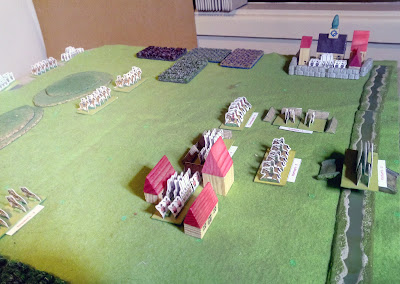Here's the setup; on the left the Royalists (under Prince Rupert) have a couple of brigades of horse on the table, and a couple of brigades of foot marching close behind them. Parliament, under Sir John Meldrum, has a defensive position based around a ruined hospital called The Spittal and some earthworks next to it, occupied by foot and flanked by horse. Beyond them are Parliament's siege guns and the town of Newark, occupied by a garrison of foot. For the purposes of the game the town of Newark is impregnable.
Both sides have reinforcements on the way, Parliament's arriving over the bridge to the rear of their deployment. They appear randomly. When the Royalist reinforcements arrived, the Newark garrison is permitted to sally forth and join the battle.
Here's Newark and the siege artillery, looking towards the Royalist approach.
A sketch map and the orders of battle. Each unit is roughly a brigade. I didn't factor reinforcements in either armies initiative value until they arrived, but did include them in the army's breakpoints.
The battle got off to an interesting start, when the initiative rolls for the first turn indicated a random event. More specifically it was the one which reduces all firing for the rest of the game, normally reflecting loss of ammunition and smoke on the battlefield, but at this early stage maybe reflecting a sudden rainstorm.
Prince Rupert concentrated his horse on the Royalist left, hoping his foot would come up on a subsequent turn. Obviously the rain slowed their march on this turn.
Both sides test for reinforcements at the start of their turn. Parliament's arrived on the first turn.
(The roll is 2D6, taking the highest. Reinforcements appear if that roll is equal to or less than the current turn).
Foot and horse from the west bank of the Trent cross the bridge to bolster Parliament's defences.
The Royalist foot arrived, and moved to cover the Royalist right against an advance from the defences. In the distance the Royalist horse can be seen; both brigades swept down towards Newark, attacking Thornhaugh's Brigade of horse on Parliament's right.
But the Royalist foot was still to far distant to prevent Parliament's horse from attacking across the front of their position, hitting Loughborough's Brigade of horse. Sir John Meldrum led them in person.
That was a mistake. Shrewsbury's brigade advanced and drove into the Parliamentarian horse, and in a confused melee, Sir John was unhorsed and captured.
Thornhaugh's Brigade also routed, leaving the infantry in the defences to turn and cover the flanks of the artillery position. The Royalist horse fell back to reform, but Hartrop's brigade of horse rode across the front of the siege guns to hit Rupert's Brigade in the flank. The guns themselves tried to fire in support, but the rain made them ineffectual.
At this point the Royalist reinforcements arrived, with Porter's horse moving to cover the flank of the Royalist foot as it prepared to advance on The Spittal and the earthworks.
The Newark garrison sallied forth against Hartrop's horse, leaving Rupert's Brigade free to engage Rossiter's horse in the centre.
Under pressure from Rupert's horse and Shrewsbury's foot, Rossiter's horse routed, and Shrewsbury's men pursued into the earthworks where King's Brigade of Parliamentarians were ill-prepared to receive them.
The Royalists finished off the third brigade of Parliamentarian horse, with Prince Rupert actually leading the Newark garrison in the fight.
The besiegers were now wavering, with all their horse gone, their commander captured and their siege artillery under attack from Loughborough's horse.
The Royalists pressed forward against the Parliamentarian defences. King's Brigade reorganised and repulsed an attack by Shrewsbury's Brigade ...
Simultaneously the energetic Prince Rupert led Loughborough's horse in an attack on the siege lines. This was too much for the Parliamentarian army, which began to fall back.
I was using a breakpoint based on hits, so although the Royalists hadn't lost a unit their army was about 75% of their way to breaking from accumulated hits. Parliament lost their commander, and three brigades of horse, with some hits on their foot and guns finally pushing the army over the edge.
I assumed that when Parliament's reinforcements arrived on the first turn that the Royalists would be faced with an uphill struggle, but the reduced firing for the whole game didn't help parliament, with their foot in the Spittal and earthworks unable to effectively support their horse with musketry from the energetic Royalists. The loss of their commander pretty much offset their advantages of numbers, and when the Royalists got their reinforcements they simply ground Parliaments force down.
This was a quick but fun game, heavily influenced by three rolls early on, generating plenty of drama.





















Great game and the right side won, huzzah!
ReplyDelete